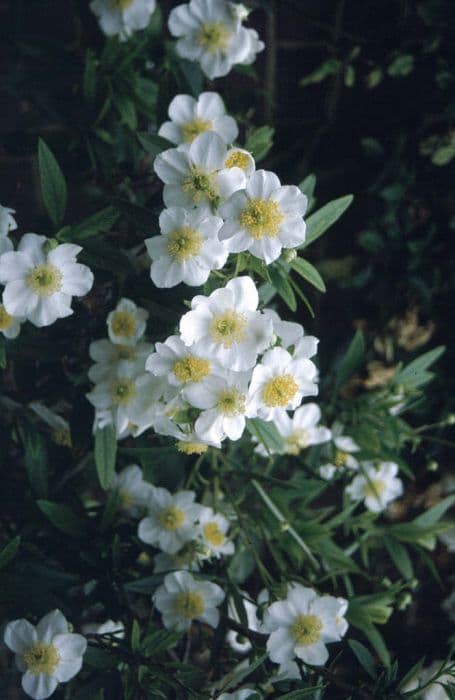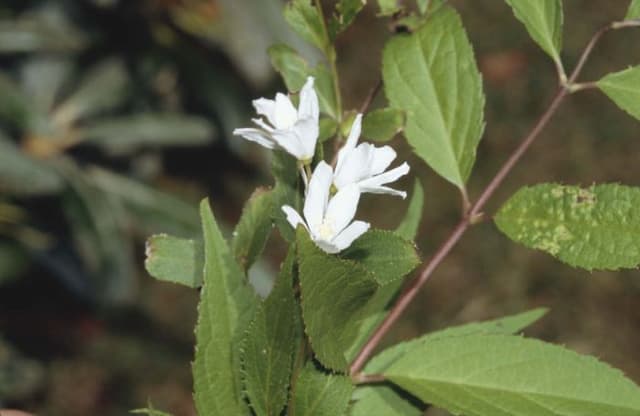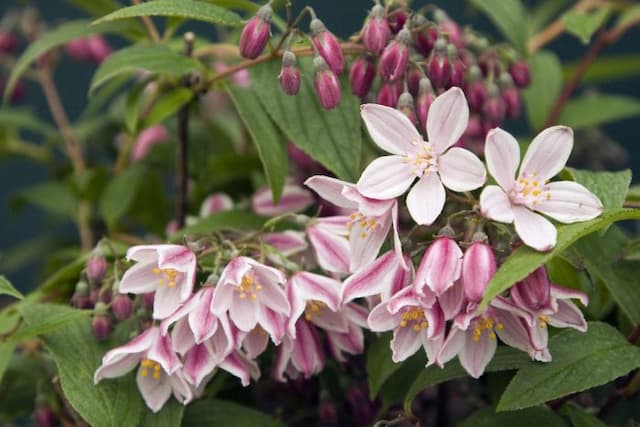Kiyosumi Mountain Hydrangea Hydrangea serrata 'Kiyosumi' (L)

ABOUT
Hydrangea serrata 'Kiyosumi' is commonly known as Mountain Hydrangea. This ornamental shrub is cherished for its elegant and delicate appearance. It bears lush, green foliage that consists of pointed, ovate leaves with serrated edges, lending a slightly textured look to the plant. The leaves can sometimes exhibit a beautiful reddish tinge along the veins, adding to the visual interest. The Mountain Hydrangea is particularly admired for its captivating flowers. The blooms present in lace-capped clusters, with small, fertile flowers at the center oftentimes surrounded by larger, showier sterile flowers around the edges, creating a tiered effect. The color of the flowers can vary depending on the soil pH, ranging from soft pinks to cool blues. The flowers tend to have a delicate, almost ethereal quality, and they stand out beautifully against the dense backdrop of the leaves. All in all, the Mountain Hydrangea 'Kiyosumi' is a plant that is revered for its picturesque foliage and enchanting floral displays that contribute to its overall graceful appearance.
About this plant
 Names
NamesFamily
Hydrangeaceae
Synonyms
Mountain Hydrangea, Sawtooth Hydrangea, Kiyosumi Mountain Hydrangea
Common names
Hydrangea serrata 'Kiyosumi'
 Toxicity
ToxicityTo humans
Mountain hydrangea contains compounds that can be toxic if ingested. These compounds, particularly the cyanogenic glycosides, can release cyanide in the body when the plant parts are chewed or digested. Symptoms of hydrangea poisoning can include gastrointestinal distress, such as vomiting and diarrhea, and more severe cases may lead to depression, lethargy, and confusion due to cyanide toxicity.
To pets
Mountain hydrangea is toxic to pets, as it is to humans, due to the presence of cyanogenic glycosides within the plant's leaves and flower buds. When ingested by pets, particularly dogs, cats, and horses, it can cause symptoms such as vomiting, diarrhea, lethargy, and abdominal pain. In severe cases, where large amounts might be consumed, the released cyanide could potentially result in more serious symptoms, including difficulty breathing, seizures, and even coma.
 Characteristics
CharacteristicsLife cycle
Perennials
Foliage type
Deciduous
Color of leaves
Green
Flower color
Pink
Height
4 feet (1.22 meters)
Spread
4 feet (1.22 meters)
Plant type
Shrub
Hardiness zones
6
Native area
Japan
Benefits
 General Benefits
General Benefits- Ornamental Appeal: Hydrangea serrata 'Kiyosumi' is known for its beautiful pink or blue lacecap flowers that provide aesthetic value to gardens and landscapes.
- Seasonal Interest: This plant offers seasonal interest with its striking blooms in spring and summer, followed by lush green foliage that sometimes changes color in the fall.
- Wildlife Habitat: The flowers attract pollinators such as bees and butterflies, contributing to the local ecosystem by supporting beneficial insect populations.
- Shade Tolerance: It is well-suited for shaded areas in the garden where other sun-loving plants might not thrive, making it a versatile choice for garden planning.
- Soil pH Indicator: The flower color can indicate the pH level of the soil, with blue flowers typically appearing in acidic soil and pink in more alkaline conditions, thus serving as a natural pH indicator.
- Compact Size: As a smaller hydrangea variety, it is well-suited for gardens with limited space or for cultivation in containers.
- Hardiness: This plant is relatively hardy and can withstand colder temperatures, making it suitable for a variety of climates.
- Low Maintenance: It requires minimal pruning and care once established, which can be ideal for gardeners seeking low-maintenance landscaping options.
 Medical Properties
Medical Properties- This plant is not used for medical purposes
 Air-purifying Qualities
Air-purifying QualitiesThis plant is not specifically known for air purifying qualities.
 Other Uses
Other Uses- Hydrangea infused tea: The dried leaves of Hydrangea serrata can be used to blend with tea leaves, providing a delicate floral flavor to the infusion.
- Photography prop: Due to its attractive blooms, Kiyosumi can serve as an excellent subject or backdrop for botanical photography and artistic compositions.
- Fabric dye: The flowers of the Kiyosumi hydrangea can be used to create a natural dye for fabrics, giving a soft blue or pink hue depending on the pH of the soil they were grown in.
- Culinary garnish: The fresh or dried flowers can be used as an edible garnish to enhance the presentation of desserts and cocktails.
- Botanical art: Pressed Kiyosumi flowers can be used in creating botanical art such as herbarium specimens or decorative framed pieces.
- Eco-friendly confetti: Dried petals of Kiyosumi hydrangea can be used as a biodegradable alternative to traditional confetti at weddings and other celebrations.
- Bookmarks: Pressed flowers can be laminated or placed within the pages of a book as an aesthetic and personalized bookmark.
- Crafting potpourri: Dried Kiyosumi hydrangea flowers and leaves can be used in potpourri mixes, adding fragrance and a touch of color to a room.
- Holiday decorations: The woody stems and vibrant blooms of Kiyosumi can be incorporated into wreaths and floral arrangements for festive decorations.
- Soil indicator: The color-changing property of Kiyosumi hydrangea flowers can be utilized as a natural pH indicator for assessing soil conditions in gardens.
Interesting Facts
 Feng Shui
Feng ShuiMountain hydrangea is not used in Feng Shui practice.
 Zodiac Sign Compitability
Zodiac Sign CompitabilityMountain hydrangea is not used in astrology practice.
 Plant Symbolism
Plant Symbolism- Heartfelt Emotions: Hydrangea often represents deep, heartfelt emotions due to its full, abundant clusters of flowers.
- Gratitude: The abundant blossoms symbolize the giver's gratitude for the recipient's understanding.
- Apoverty: In some cultures, hydrangeas can symbolize frigidity and boastfulness, relating to an old Japanese legend where an emperor gave hydrangeas to a maiden he loved as an apology for neglecting her. This has led to a tradition of giving hydrangeas as a gesture of apology.
- Vanity: The lush appearance of the hydrangea can symbolize vanity and self-absorption.
- Abundance: The voluminous nature of the hydrangea's flowers symbolizes abundance and prosperity.
- Beauty: The delicate and beautiful nature of the blossom represents the beauty found in life.
 Water
WaterMountain hydrangeas like the 'Kiyosumi' variety need consistent moisture, so water them deeply once a week with about 1 gallon of water, particularly during dry periods. The soil should be kept moist but never waterlogged. During hotter seasons or if planted in a pot, they might require water twice a week. Always check the top inch of the soil for dryness before watering. Avoid wetting the foliage to prevent fungal diseases.
 Light
LightMountain hydrangea prefers dappled shade or morning sun with afternoon shade. The best spot would be in an area that receives filtered sunlight for most of the day, as direct, harsh sun can scorch the leaves. East-facing locations or the north side of buildings where they can receive bright morning light and protection from intense afternoon rays are ideal.
 Temperature
TemperatureMountain hydrangeas thrive in a range of temperatures but prefer consistently cool to moderate climates. They can survive in temperatures as low as 20 degrees Fahrenheit in winter and as high as 80 degrees Fahrenheit in summer. The ideal temperature range for promoting good growth and blooms is between 50 to 70 degrees Fahrenheit.
 Pruning
PruningPrune mountain hydrangeas to remove dead wood and shape the plant in late winter or early spring before new growth emerges. Pruning just after blooming can be done to maintain a tidy appearance. However, avoid heavy pruning later in the season as this can remove next year's buds. Prune faded flowers to encourage new growth and potential rebloom.
 Cleaning
CleaningAs needed
 Soil
SoilThe Mountain Hydrangea prefers moist, well-drained soil with high organic matter. A mix of peat, compost, perlite, and garden soil works well. Aim for a soil pH of 5.5 to 6.5 to keep its foliage and blooms healthy. Acidic soil conditions can also enhance the blue coloring of the flowers.
 Repotting
RepottingMountain Hydrangeas should be repotted every 2-3 years to refresh the soil and accommodate root growth. Spring is the best time for repotting, just before the growing season starts.
 Humidity & Misting
Humidity & MistingMountain Hydrangeas thrive in environments with medium to high humidity levels. Aim for around 50-60% relative humidity for optimal plant health and bloom production.
 Suitable locations
Suitable locationsIndoor
Place in bright, indirect light; keep soil moist.
Outdoor
Part shade, sheltered location, moist fertile soil.
Hardiness zone
6-9 USDA
 Life cycle
Life cycleThe Mountain Hydrangea 'Kiyosumi' begins its life cycle as a seed, which upon germination, grows into a young plant known as a seedling. As the plant matures, it develops a root system and foliage in a vegetative stage, followed by the development of buds that lead to its flowering stage during the spring and summer. After pollination, it enters the reproductive stage, producing seeds for further propagation. Throughout the growing seasons, the Mountain Hydrangea 'Kiyosumi' experiences cycles of growth and dormancy annually, with leaves falling in autumn and a period of winter dormancy before regrowth in spring. Following several years, the plant reaches maturity, where it can continue to grow and reproduce for many years. The life cycle eventually ends when the plant succumbs to age, environmental conditions, or disease.
 Propogation
PropogationPropogation time
Early Summer
Hydrangea serrata 'Kiyosumi', commonly known as mountain hydrangea, is best propagated by softwood cuttings taken in late spring to early summer when the plant's new growth is still tender and green. To propagate by this method, a gardener should select healthy shoots that have just begun to mature and cut a 4- to 6-inch (approximately 10 to 15 cm) length, making sure to include several leaf nodes. The lower leaves are removed, and the cut end is dipped in rooting hormone to enhance root development. This cutting should then be planted in a well-draining soil mix, kept moist, and covered with a plastic bag or placed in a propagator to retain humidity. Roots usually develop within 4 to 6 weeks, after which the new plants can be transplanted to individual pots or directly into the garden.








![Hydrangea [Strong Annabelle]](/_next/image?url=https%3A%2F%2Fplants-admin.emdemapps.com%2Fimages%2Fplants%2F%2Fimages%2F604b54db37d34.png&w=640&q=75)
